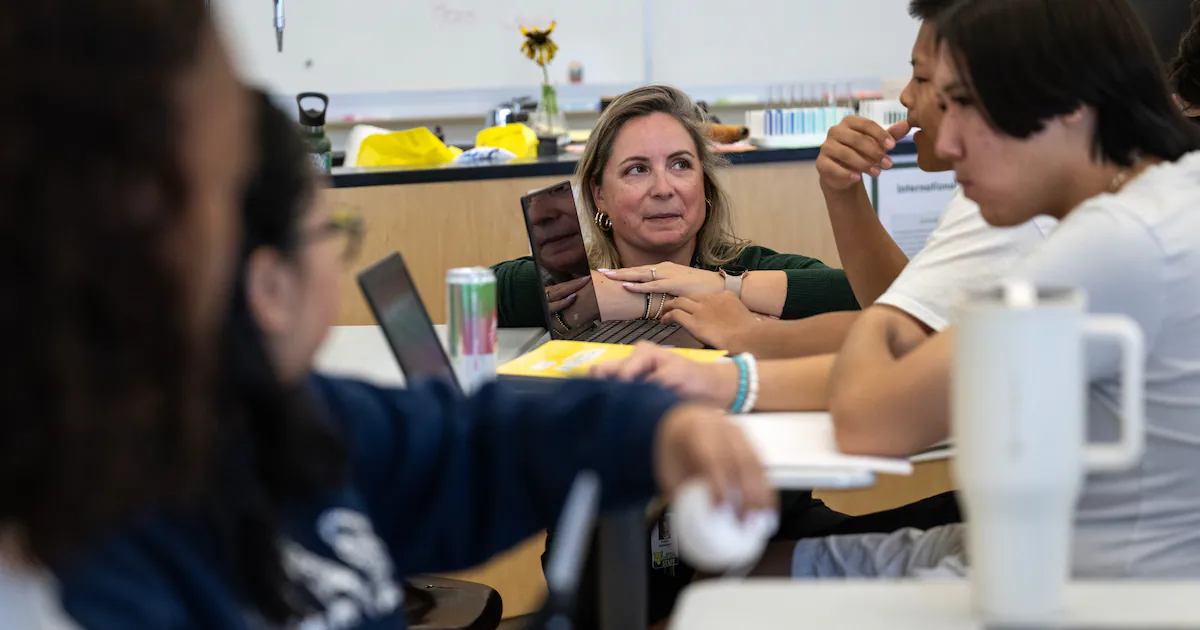
Pamela Sebwenna is a certified medical assistant and leads the front desk of Advanced Body Solutions, a medical massage therapy clinic in Anchorage.
Sebwenna graduated from Service High School in 2022 and studied in its biomedical career academy. She said the academy allowed her to get a job in her preferred field at an assisted living facility immediately after she graduated.
“It makes the high school experience a little different,” Sebwenna said. “It’s a little more enjoyable if you’re doing something that you want to do.”
Sebwenna said she was better prepared for her college anatomy and physiology class after going through Service’s rigorous biomedical academy. She said when professors brought out an anatomage table, she was one step ahead of her classmates.
“It was much less intimidating in college because I had the experience with it in high school,” Sebwenna said. “I think it really broadens the view for students to think of what their future can look like, and it prepares them for the real world a little bit.”
Starting this year, high school students across the Anchorage School District have similar opportunities. This is the second year of the district’s Career Academies initiative, which offers career training classes at every Anchorage high school as part of an effort to boost graduation rates and bolster the local workforce. After the initial rollout of a mandatory class for freshmen last year, fall 2025 marks the first time that every high schooler in the district can choose to learn more about a potential career.
However, the program’s future is now at risk.
In 2023, the district was awarded a five-year, $14 million federal grant through the Fostering Diverse Schools program, which was meant to support career and technical training. But last week, the grant wasabruptly defunded by the federal Department of Education. The district will not receive a total of $8.9 million over three years of grant funding unless the federal government grants the district’s appeal.
It’s not clear if Anchorage school leaders will be able to make up the difference with local and state funding. Even with the increase to state funding that legislative leaders pushed through this year, officials estimate the Anchorage School District is facing another $70 million deficit this year.
School board member Andy Holleman summed up the potential future of the academies in an interview Friday:
“Uncertain,” Holleman said. “The issue with the academies is that there were a number of positions that were funded with the grant that now are going to be absorbed by our budget. To fill them out and fill out all the pathways is going to take more staff. I don’t know how we add staff right now without actually cutting another program, so it is going to be a difficult puzzle going forward.”
Anchorage Superintendent Jharrett Bryantt told school board members that they should prioritize funding the program if they want to keep it.
Asked by a school board member what the federal funding loss could mean for the academies on Tuesday, Bryantt said, “any of these priorities are as vulnerable as the school board allows them to be vulnerable.”
When announcing the federal funding cutoff, Bryantt in an email said the district would evaluate potential next steps to sustain the program.
A spokesperson said the district couldn’t provide an estimate for how much the academies have cost to implement in time for this story.
Holleman said it’s possible the district could seek different federal grants, or that the district’s appeal may be approved because career training supported by the grant has little correlation with diversity, equity and inclusion initiatives the Trump administration is cracking down on. Holleman said partnerships with private-sector businesses could also help.
Before the academies launched, some community members were hesitant to support the program.
An initial proposal included moving to an eight-period day, two more than high school students currently take. Alaska has one of the shortest school years in the country, and some parents were concerned that adding extra class requirements would put students at a disadvantage by reducing the amount of time they spend studying core subjects.
Also, when the school board voted to approve the academies in 2024, members questioned whether there would be enough interest from students to make the program worth it.
So far, there is plenty of interest. Last year, nearly 8,000 students took career and technical education courses, about one-third of all 10th to 12th graders districtwide.
Bryantt also points to improved graduation statistics: In the 2023-24 school year, 98% of students who passed two courses in a training area were on track to graduate.
“I think one of the reasons why so many of those students graduate is because they can see that future,” Bryantt said during an event Wednesday. “They can see that finish line that means financial freedom and an opportunity to break cycles of poverty, which is really powerful.”
A long history of job training
Career-focused courses were well-established in Anchorage before the academies started. The district celebrated the 50th anniversary of King Tech High School earlier this year, which still houses more career training options under one roof than any other school in the district.
Elements of what would become the Career Academies also existed for years in various forms around the district — Service and Bartlett each developed their own standalone biomedical academies over a decade ago, and versions of a freshman academy course existed at several schools.
Along with community input, the demand for career training through King Tech and other standalone job training programs led district officials to try to expand students’ access to career education opportunities through the new academies.
The district added 25 new career pathways this year. Many career-focused courses allow students to earn dual credit in math or science. Among the most popular new pathways is a digital art and design course offered at six schools.
ASD Career and Technical Education Director Devon Roberts compares the expanded course options to the notoriously exhaustive Cheesecake Factory menu.
“It’s a bigger menu,” Roberts said. “A lot of these courses that are new are sort of survey foundational courses to really ground students in the ability to see across a career or an industry.”
The district also has long provided internship and job shadowing opportunities over the summer, but the academies have increased demand. While only about a dozen students typically used to get summer internships through the district, that figure exploded this year to nearly 50 summer internships.
Service High School teacher Kaitlyn Williamson, who started the biomedical academy in 2010, said she’s flagged down by several of her former students anytime she visits the hospital.
“They follow along with what we’re doing and they email me all the time. ‘How can I help?’” Williamson said. “… It’s that feeling, that community that keeps students with us.”
Thaddous Jackson teaches computer science to sophomores enrolled in his cybersecurity class at Service, and said his students want hands-on experience.
“It’s the game design that’s kind of like the hook to get them into it, and then they all want to be cybersecurity specialists. They want to learn about ethical hacking, if you will,” Jackson said. “The majority of them that apply for this pathway, they want a career in computer science in some form or fashion.”
Orion Edwards, a 15-year-old sophomore at Service with an interest in computer science, said he’s now looking forward to a career in technology after he graduates high school.
“I mean, it could range from coding and creating a website to making characters in video games,” said Edwards. “Really, I’m interested in the animating and the coding and just anything. Software or hardware doesn’t really matter to me, it’s all very interesting.”
Service High School Principal Imtiaz Azzam said she is proud of the career training opportunities available at Service, including an influx of girls taking construction courses. She rejected the premise popular among previous generations that high school is meant solely to prepare students for college.
“We need to prepare them for career and for life. When we say career, then let them discover those, explore those opportunities we have for them, and shame on us if we don’t,” Azzam said.
District officials also reworked a mandatory freshman-level course called “Career, College Exploration and Personal Finance” to fit recently changed state standards. The class is meant to teach students soft skills and introduce them to potential careers while providing experiences such as a visit to the University of Alaska Anchorage and a career expo, scheduled for this coming Friday.
Help needed at home
Employers at health care facilities locally say that years after the COVID-19 pandemic, they still see a shortage of workers across the industry. Officials with Providence Alaska Medical Center hope locally produced talent could help fill those gaps.
According to an analysis of Alaska’s health care workforce from the Alaska Hospital and Healthcare Association, Alaska is expected to have among the most significant health care worker shortages in the nation. The report says that about 3,500 workers are needed, but fewer than 800 people graduated from local programs to fill those vacancies.
Billie Comley was one of the first graduates from Service’s biomedical academy, and started working at Providence Alaska Medical Center in 2013. She’s now an Intensive Care Unit pediatrics nurse, and says an influx of qualified health care workers is needed.
“We feel the shortage every day,” Comley said.
Nancy Wingate, a medical dosimetrist at Providence, coordinates internships and job shadowing opportunities for students. Wingate said Alaska-grown students are often more likely to stick around in the health care industry.
“If you have homegrown, that’s not a surprise for anyone. You know what the winters are like, you know what the seasons are like, and if that fits you, then great,” Wingate said. “We have a great opportunity here for you.”



